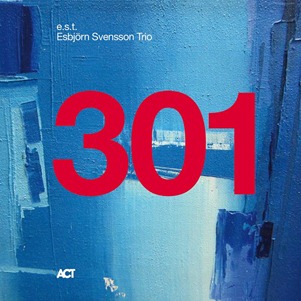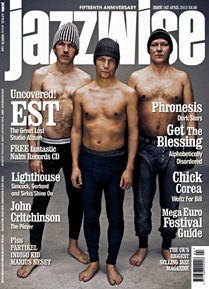Whenever I listen to e.s.t., the Esbjörn Svensson Trio, I am never sure how to classify it. Jazz? Neo-Classical? Electronica? But in the end, I get lost in the music and the labels no longer are important. For the uninitiated, e.s.t was the planet conquering Swedish jazz piano trio formed in 1993 consisting of Esbjörn Svensson (piano), Dan Berglund (double bass) and Magnus Öström (drums). Its music has classical, rock, pop, and techno elements.
e.s.t. was a phenomenon: A jazz trio, that saw itself as a pop band that plays jazz, which broke with the tradition of leader and sidemen in favor of equality within its members, which not only played jazz-venues but also venues usually reserved for rock bands, which used light effects and fog-machines in their live shows, which got a whole audience to sing-a-long to jazz-standards as eg. Thelonious Monk's "Bemsha Swing", is a trio that goes beyond the scope of the usual classic jazz trio. Their music was found in the pop-charts and their videos played on MTV Scandinavia. With their unique soundscape, combining jazz with drum 'n' bass, electronic elements, funk rhythm, and pop and rock as well as European classical music,e.s.t. won an audience spanning from the classic jazz fans to the younger hip hop fans. Critics and audiences worldwide agree: e.s.t. was one of the most innovative jazz bands of the 21st century.
In January 2007, e.s.t. was on tour in Asia and Australia performing shows in Tokyo, Osaka, Yokohama, Jakarta, Perth and Sydney. It was their third tour of Japan and their second time on the continent; and the venues and audiences had become noticeably bigger. Only a few weeks before, they had finished their triumphant tour of Germany, including a legendary performance in Hamberg which resulted in Live In Hamburg (ACT, 2007), awarded "Album of the Decade" by the London Times. It was undoubtedly the prime time for the style-defining jazz band of the 2000s.
The album is a follow up to e.s.t.'s 2008 effort, Leucocyte , and is the group's second album following pianist Esbjörn Svensson's tragic death (prior to Leucocyte's release). Heralded as one of the most exciting jazz bands of the decade. The seven tracks presented here are awe inspiring. there is a kind of peace that flows from the speakers or head phones or whatever, that grab you and infuse you with a brilliant calm that will convince the listener that they are hearing music take on a whole new dimension.
From the start, one of e.s.t.'s defining characteristics was their seemingly effortless and interconnected interplay, which was on such a high level that it seemed to suggest that they were "three mutant bodies with six arms and one brain" . That connectedness becomes very important when jamming without net in a studio marathon like e.s.t. did in Sydney on these recordings. It was while in Sydney, during that 2007 tour when they packed arenas as if they were a rock band that the group rented the famous "Studio 301" in for their off-days in the middle of the tour. They jammed for two consecutive days developing new songs and material. All told, they recorded nine hours of music. Leucocyte became the first release from these sessions and won the praise of critics and fans as a ground-breaking work that leads into a new musical universe. Very soon after the recording, Svensson had edited much of the material down to two albums. And so the plan at the time was to release either a double album or two consecutive albums from this recording. Svensson's tragic passing on June 14, 2008 (as a result of a scuba diving accident) disrupted this undertaking and only one of the albums, Leucocyte (ACT, 2008), was released at the time.
The recording sessions in "Studio 301" are not only a jam, but involved e.s.t. ́s sound engineer Ake Linton in the creative artistic process. Linton had traveled with the band since early 2000 and was the man behind the mixing desk for over 500 shows. Together with him,e.s.t. had designed their own recognizable trademark sound and Linton made sure that wherever they went and performed this sound was recognizable. During the recording process at "Studio 301," he would contribute by running effects, overlaying distortions and add-ins live through the desk and onto tape. This procedure is especially delicate as it cannot be reversed during mixing sessions. Therefore it is no surprise that both Leucocyte and now also 301 were finally mixed and mastered at Bohus Sound Recording in Gothenburg and involved Linton as the mixing engineer.
The result is music that transcends jazz, that goes beyond neo-classical, that lends a sophistication to pop music. Svensson's death put a much too early end to e.s.t.'s creative output, at a point where the group was just beginning to receive greater recognition in the United States. For Berglund and Öström it has been a painful process to revisit the Sydney recording. Both had to move on after the sad events of Svensson's death in 2008. Berglund regrouped with pre-e.s.t.-era musical friends and formed the indie-outfit "Tonbruket," Magnus Öström released his solo-album Thread of Life featuring an Esbjörn Svensson tribute song by Bergland and Pat Metheny.
Hopefully, with the release of 301 north America will finally get to hear this musical phenomena's brilliant works, and the direction this trio of musical brothers, attached at the brain, but also the soul, were able to accomplish.
Copyright © 2012 Robert Carraher All Rights Reserved





No comments:
Post a Comment